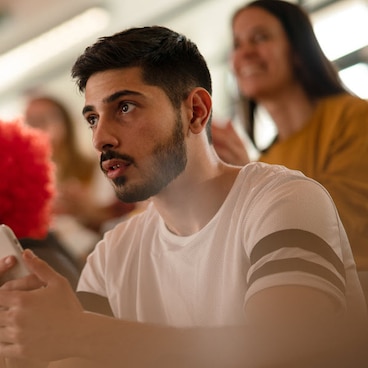
Kevin Siemiawski is somewhat of a legend at Schwab’s trade desk.
Straight out of high school in 1978, Kevin’s dad told him that he needed to get a job, so he went to the Midwest Stock Exchange, which later merged with the Chicago Board Options Exchange. It was the height of floor trading where traders in colorful jackets representing different brokerage firms shouted orders and waved their hands to communicate across the floor, competing for the best prices, feeling the highs and lows of the market together in the barely controlled chaos of ‘the pit.’ It’s here that Kevin started as a runner transmitting orders between clerks and brokers.
On his 21st birthday Kevin got his own trading badge and moved up to become a floor trader and eventually a market maker, joining the throngs in the pit and owning his own company for nine years. In fact, it’s here, in 1981, where he befriended the future co-founder of thinkorswim, Inc.—the brokerage firm that developed the trading platform of the same name that is now part of the suite of tools available to Schwab clients.
Kevin in 1983, when he was a floor trader.

And now, as trade pits have transitioned to sound stages, Kevin looks back fondly at the pandemonium of the ’80s.
“In a way, I think it’s harder to trade now, against a screen,” says Kevin. “In the pit, you can feel the energy. Behind a screen you don’t have the emotion.”
But the pit eventually got the best of Kevin. After a trip to the doctor, he learned he had nerve damage in both ears due to the decibel level on the trading floor. As a result, Kevin took a brief and ill-fitting detour to culinary school. But as he says, “I couldn’t take it. I wanted to get back in the business.”
So he called up his old trading buddy, joining his RIA firm and eventually becoming one of the first employees of thinkorswim® in 1999.
“I was there as we built up thinkorswim, and we believed it was the best platform in the world,” says Kevin. “And we recruited some of the best floor traders. Everyone around me was the best.”
Navigating change
You can’t be in any business for 40 years without things changing. Most dramatically, trade floors emptied as trading transitioned to digital. And for Kevin, he saw thinkorswim go through acquisitions, which led him to Ameritrade and now Schwab where he works at the trade desk as an options specialist.
In addition to helping clients with trading needs, Kevin’s helped clients navigate change. With his depth of experience, there’s not much he hasn’t seen.
“After the pandemic, I saw people who were thinking of trading as more of a video game. Some knew what they were doing, some didn’t,” he says. “But I’m one of the oldest guys here and I have a different outlook. I try to tell them that now it’s more important than ever that they know how to use our system and that they do their homework and have a strategy. I like to show them to look at what would happen if they look on the Analyze tab or show them how to set up complex orders. I believe we have the best platform there is so I think they should use it.”
As an ‘old school’ trader, Kevin’s ideal call is when a client wants to do a big trade in futures or they want to execute an iron condor, a complicated options strategy. He thrives when the markets are volatile. In fact, many of the reps around him will say they’ve learned much about these types of strategies from him. But Kevin says he’s learned just as much from them. Coming from the pit, Kevin wasn't as naturally inclined toward customer service, so he says he learned that part from ‘the kids,’ as he calls the other trade reps.
“What they learned from me, I learned different things from them,” he says. “It’s been satisfying to see all the reps who started working after me who are now managers and directors. It just shows the level of talent that came out of thinkorswim and continued with Ameritrade and now with Schwab. I don’t think there’s a more experienced trade desk anywhere.”
Ending at the beginning
So it’s quite the path that’s led Kevin from the pit to Schwab’s trade desk, and with four decades of experience, he’s seen a little bit of everything. But even so, if you ask someone about Kevin Siemiawski, chances are, they are going to look at you with a blank stare and say, “Who?”
But if you ask about, “Zep,” they’ll say, “Oh yeah, Zep,” and then tell you about how he taught them about trading when they first started, or how they heard he was recruited straight from the floor 40 years ago.
“Zep” stems from Kevin’s very first day as a trader when on November 17, 1981—his 21st birthday—he went to get his first badge for the pit. His initials, KMS, were already taken. So he chose ZEP, an homage to his favorite band, Led Zeppelin.
It’s been a calling card and a name that’s stuck ever since. Longtime clients may even remember Zeppy the monkey, thinkorswim’s mascot, which was named after him. It’s when he picked up that badge with the letters Z-E-P that the origin story of this trading legend began. And the legend continues every time he picks up the phone to help a client.


